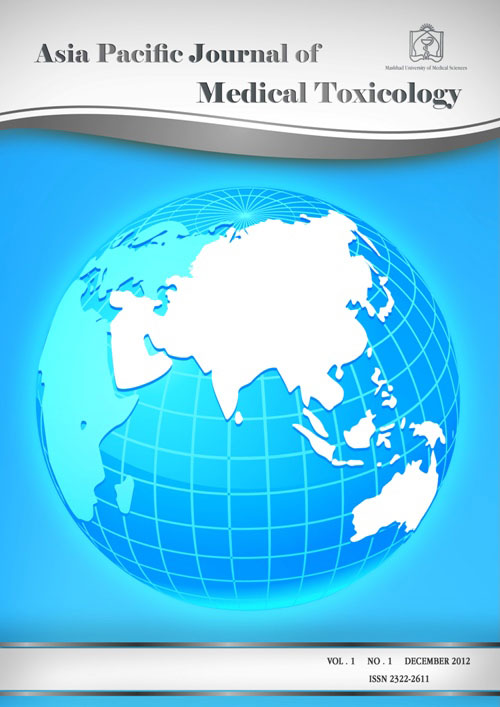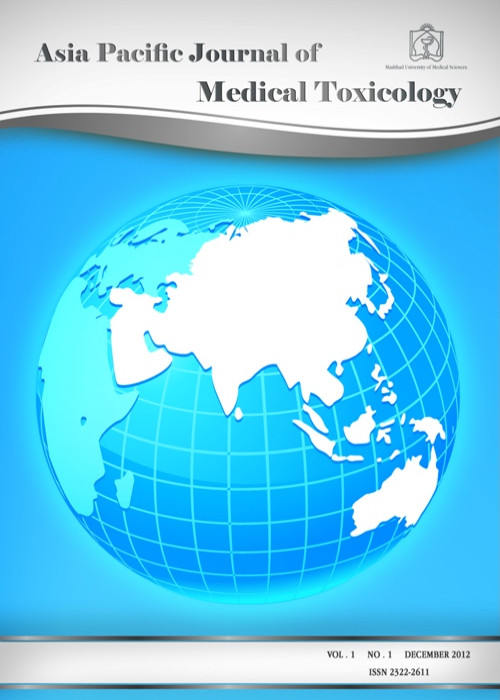فهرست مطالب

Asia Pacific Journal of Medical Toxicology
Volume:7 Issue: 1, Winter 2018
- تاریخ انتشار: 1396/12/11
- تعداد عناوین: 7
-
-
Pages 1-6BackgroundIn maintenance therapy for opioid addiction, to reduce the risk of buprenorphine (BUP) abuse, the combination of BUP and naloxone (NX) has been developed and is commercially available as suboxone (BUP/NX). This study was designed to compare addiction relapse frequency in patients receiving BUP and BUP/NX as maintenance therapy.MethodsIn this double-blind clinical trial with cross over design, 100 opioid abusers were randomly assigned to two treatment groups to receive either BUP or BUP/NX. After three months, without a time-out period, subjects undertook treatment with the other drug. The subjects were screened weekly for urinary morphine.ResultsIn each of the study arms, when the patients were given BUP/NX, the number of relapses was significantly higher compared to when they received BUP (0.13±0.24 vs. 0.04±0.09, P = 0.001). If participants age was taken into account, the number of relapses was significantly higher when BUP/NX was given in age groups of 31 to 40 years and over 50 years (PConclusionBUP seems to be more effective than BUP/NX in preventing addiction relapse in opioid abusers under maintenance treatment.Keywords: Buprenorphine, Naloxone Drug Combination, Opioid-Related Disorders, Recurrence
-
Pages 7-12BackgroundAlthough studies are available on lipid peroxidation products and the antioxidant status in experimental animals, a detailed report on human exposed to diesel combustion nanoparticles is meagre. We aimed to study the variation in oxidative stress markers among exposures.MethodA cross-sectional study during the period between 2015-2017 was conducted among 500 male garage workers of age group 25-40 years with history of exposure for 6-8 hrs a day without using any protective aids during work, for 6-12 years and 300 controls, who live in hilly areas where they were sparsely exposed. Serum oxidative stress markers were estimated and compared.ResultsA significant variation was observed among the oxidative stress markers in exposures with surge in melanaldehyde (MDA) and reduction in superoxide dismutase (SOD) and catalase (CAT).ConclusionUnprotected exposure to diesel combustion products induces oxidative stress which can alter recordable change among the markers. Oxidative stress, being the route cause for cell damage, can be marked in the initial stages and is a good biomonitoring factor in primary care.Keywords: Diesel Combustion Nanoparticles, Lipid Peroxidation, Melanaldehyde, Oxidative Stress Markers, Superoxide Dismutase, Catalase
-
Pages 13-16BackgroundSnakebite is one of the most common health problems in endemic regions such as Iran. Due to the potential lifethreatening impact of snake envenomation and biodiversity of snakes, it seems that epidemiological studies are required, as the primary step to design standard and local therapeutic protocols, regarding the national and regional facilities and therapeutic needs.MethodsThis investigation was conducted with a retrospective design, by studying all the records of patients affected by snakebite and hospitalized in Sina Hospital during 2006 to 2011. Epidemiological data and also the outcomes of patients (including side effects and survivals) were collected. The data were analyzed by SPSS software version 18, using descriptive statistics and Chi-Square test. PResultsA total of 287 snakebite patients were studied. 73.5% of patients were men and most of them belonged to the age group of 15-34 years. Most common complaints of patients once admitted were pain (74.6%) and edema (43.9%). 96.5% of the patients received 5-10 vials of anti-venom. The most prevalent side effect observed was coagulopathy 70.7%). A significant relationship was found between the anti-venom onset after the bite and the rate of coagulopathy occurrence (p=0.035). Three deaths had occurred in general.ConclusionEarly referral to medical centers and administration of anti-venom has been accompanied by significant improvement in outcomes, and would reduce the hematological side effects, need for administrating blood products, and probably the need for administration higher anti-venom doses.Keywords: Manifestation, Outcome, Snakebite, Treatment
-
Pages 17-19BackgroundSnakebite is one of the most common health problems in endemic regions such as Iran. Due to the potential lifethreatening impact of snake envenomation and biodiversity of snakes, it seems that epidemiological studies are required, as the primary step to design standard and local therapeutic protocols, regarding the national and regional facilities and therapeutic needs.MethodsThis investigation was conducted with a retrospective design, by studying all the records of patients affected by snakebite and hospitalized in Sina Hospital during 2006 to 2011. Epidemiological data and also the outcomes of patients (including side effects and survivals) were collected. The data were analyzed by SPSS software version 18, using descriptive statistics and Chi-Square test. pResultsA total of 287 snakebite patients were studied. 73.5% of patients were men and most of them belonged to the age group of 15-34 years. Most common complaints of patients once admitted were pain (74.6%) and edema (43.9%). 96.5% of the patients received 5-10 vials of anti-venom. The most prevalent side effect observed was coagulopathy 70.7%). A significant relationship was found between the anti-venom onset after the bite and the rate of coagulopathy occurrence (p=0.035). Three deaths had occurred in general.ConclusionEarly referral to medical centers and administration of anti-venom has been accompanied by significant improvement in outcomes, and would reduce the hematological side effects, need for administrating blood products, and probably the need for administration higher anti-venom doses.Keywords: snakebite, manifestation, treatment, outcome
-
Pages 20-23BackgroundAmlodipine belongs to the dihydropyridine class of calcium channel blockers (CCB). We present a patient who concomitantly overdosed on amlodipine and subcutaneous insulin.Case PresentationAn elderly man presented within 2 hours to the Emergency department after ingesting 140mg of amlodipine and self-injected 2 cartridges of NovoMix 30/70(600 units) in a suicidal attempt. He developed mild hypotension and had multiple episodes of hypoglycemia but was otherwise asymptomatic. He was managed with activated charcoal, low dose noradrenaline and multiple doses of dextrose for his hypoglycaemia. He was discharged well after 3 days.DiscussionThe clinical manifestations of dihydropyridine toxicity are hypotension, hyperglycaemia and metabolic acidosis. Our patient was elderly with multiple medical problems but he was alert and haemodynamically stable on presentation. Activated charcoal is the recommended form of decontamination when the patient presents early. He also developed initial hyperglycemia, which correlates with the degree of the calcium channel blocker overdose. The early coadministration of insulin would correct the patients hyperglycemia, acidosis, myocardial function and even provide inotropic support. It may be possible that the subcutaneous route of administering high dose insulin has similar effects as those of intravenous HIET. Our patients hypoglycaemia occurred about 12 hours of the overdose, which is expected after an insulin overdose. He required many boluses of dextrose infusions before his blood sugar level stabilised.ConclusionIt is postulated that self-administration of insulin and early decontamination could have resulted in patients good outcome despite having ingested a potentially fatal dose of amlodipine.Keywords: Amlodipine, Hypotension, Insulin, Overdose
-
Pages 24-27BackgroundIn Vietnam, there are two main species of Bungarus: Bungarus multicinctus and Bungarus candidus. Trypsin is a serine protease digestive enzyme that has demonstrated efficacy in some of Elapidae envenomations. After their experiments with dogs and mice, Hsiung Yu-Liang et al. concluded the local injection of trypsin can be used in clinical practice as a new and effective therapy for snakebite. We report a case of successful application of alphachymotrypsin, a related enzyme, in the treatment of severe paralysis due to B. multicinctus snakebite.Case PresentationA 38-year-old man was bitten on his left hand by B. multicinctus. Two hours after the bite, the patient developed a sore throat, diffuse myalgia, and progressive paralysis. Since antivenom was not available, we decided to administer alphachymotrypsin after the risks and benefits were carefully discussed. A dose of 5000 IU alphachymotrypsin was administered by the IM route at 24 and 31 hours after bite. At the time of the first dose of alphachymotrypsin, muscle power was 0/5. The muscle power improved rapidly, from 0/5 (24 hours) to 2/5 (at 44 hours). After that, additional doses of 10.000 IU of alphachymotrypsin were administered at 45, 55, 69, 75, 94 and 100 hour after the bite; the muscle power increased gradually then to 3/5 (66 hours), 4/5 (75 hours), and 5/5 (97 hours).DiscussionThe severity of the patient can be estimated through some factors as following: the heavier and longer the nake, the more severe the threat, time from bite to symptoms: the sooner the more severe, the level of paralysis, and the level of hyponatremia. According to these signs, the patient was classified under the severe group because the snake was long and heavy (1.5 m and 300 gr), symtoms appeared right after 2 hours after the bite, and level of paralysis was 0/5 17 hours after the bite. The mild hyponatremia could be related to either a minor B. multicinctus envenomation, which is unlikely given the severity of the other clinical findings, or the effectiveness of alphachymotrysin. This hypothesis requires further investigation, both mechanistically and clinically.ConclusionThe use of alphachymotrypsin was associated with a shortening of the need for mechanical ventilation, length of ICU stay, and a reduced extent of hyponatremia in a patient with severe B. multicinctus envenomation.Keywords: Alphachymotrypsin, Bungarus Multicinctus, Snakebite


